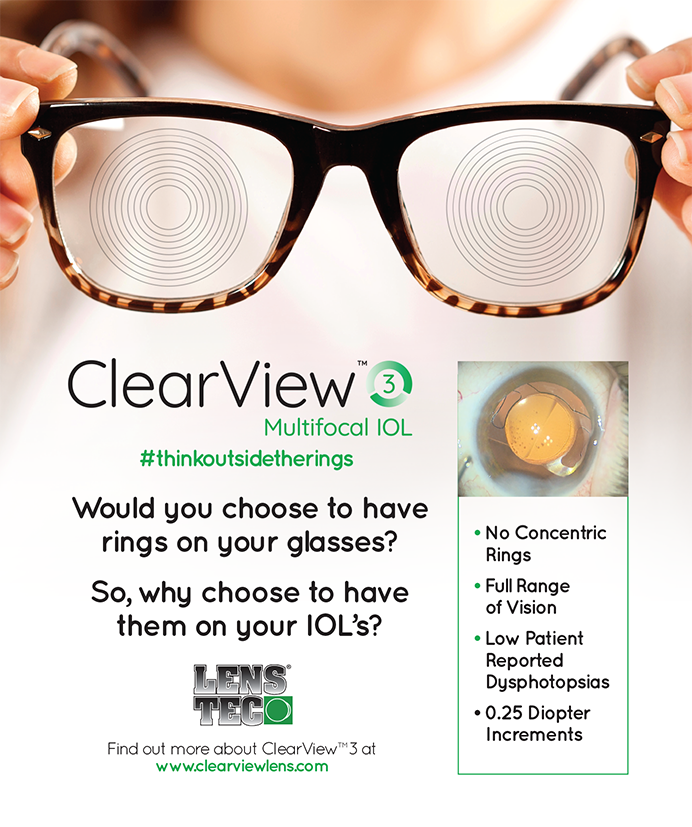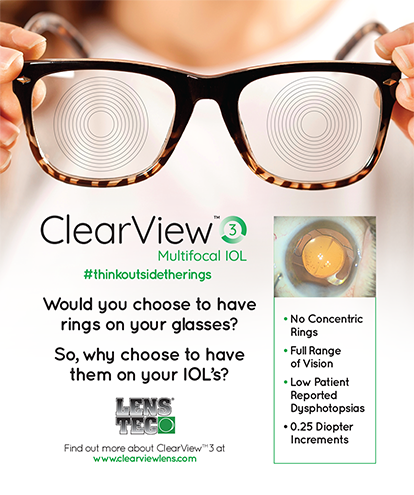An evaluation of the ocular surface is one of the most important aspects of my preoperative routine for any patient who is considering LASIK. Dry eye can significantly compromise patients' quality of vision, even after routine laser vision correction.
Essentially all patients experience at least transient dry eye after LASIK.1 Postoperative dry eye is arguably the most common problem facing LASIK surgeons today.2-4 After the procedure, the cornea overlying the flap is significantly anesthetic for 3 to 6 months.2-4 As a result, all patients will experience a decrease in tear production. Only those patients with dry eye before surgery, or who were marginally compensated preoperatively, will have symptoms. In addition, most patients with post-LASIK dry eye will undergo a disruption of the tear film and ocular surface and therefore will complain of fluctuating visual acuity between blinks during different times of the day. Fortunately, the great majority of these patients' symptoms will resolve over a 2- to 4-week period after surgery. My colleagues and I have evaluated patients in our practice for dry eye before and after LASIK. We have found a 15 incidence of moderate dry eye that lasts at least 3 months and a 5 incidence of severe dry eye that lasts no less than 6 months.
ETIOLOGY OF POST-LASIK DRY EYE
There are many possible etiologies for the worsening of dry eye syndrome after LASIK. The high level of pressure induced by the suction ring during the procedure may damage the conjunctival goblet cells and may compromise the mucin layer of the tear film. Significant alterations to the corneal curvature that occur after LASIK alter tear wetting, as the lids move over the modified ocular surface. Medicamentosum, caused by epithelial toxic antibiotics, nonsteroidal anti-inflammatory drops, and preservatives, may also induce transient dry eye symptoms. Because intact corneal sensation partially drives tear production, corneal denervation associated with the LASIK procedure is the most likely etiology of dry eye postoperatively.
PREVENTING POSTOPERATIVE DRY EYE
There are several steps that one may take to reduce the incidence of dry eye following LASIK. One of the most important ways to prevent postoperative dry eye is to screen patients more carefully before refractive surgery. Many patients seeking refractive surgery are actually preselected dry eye patients who are contact lens intolerant. Because their preexisting dry eye syndrome causes them discomfort while wearing their contact lenses and renders them contact lens intolerant, they often seek LASIK for visual rehabilitation. Any mention of contact lens intolerance during the course of the patient's history should strongly suggest the possibility of underlying dry eye. In addition, long-term contact lens wear decreases corneal sensation, and hard contact lenses have a more pronounced effect. This decrease in corneal sensation related to the long-term use of contact lenses would be additive to the decrease seen with LASIK surgery and would contribute to decreased tear production.5
DRY EYE HISTORY
The dry eye history is perhaps the most important part of the dry eye workup. We ask all patients whether they experience any eye irritation, including sandy-gritty irritation, dryness, burning, or foreign body sensation. We carefully inspect the lids of patients who experience eye irritation upon waking in the morning for signs of meibomitis, and we pay close attention to the status of the meibomian gland orifices, the width of the palpebral fissure, and the volume of the tear film in patients who report that their symptoms worsen as the day progresses. Stenosis and closure of the meibomian glands, a very wide palpebral fissure, and decreased tear production all increase tear film osmolarity and cause dry eye. We perform basic tear testing, including tear film breakup time. We look for tear debris in the inferior cul-de-sac and perform Schirmer testing with anesthesia. Most importantly, we perform supravital staining of the conjunctiva with lissamine green or rose bengal and fluorescein staining of the cornea to look for the classic staining pattern of dry eye.
According to the literature, the efficacy and safety of LASIK are not affected by preexisting dry eye, but it is a risk factor for symptomatic post-LASIK dry eye with measurably lower tear function and supravital staining of the ocular surface.6,7 We consider conjunctival staining a risk factor for dry eye postoperatively and corneal staining to be a relative contraindication for surgery. In patients who have dry eye symptoms preoperatively, it is important to maximize the health of the ocular surface prior to initiating surgery, because it is easier to pretreat these patients than to react to them postoperatively.
TREATING DRY EYE BEFORE SURGERY
All patients with dry eye syndrome contemplating LASIK should receive treatment for dry eye before surgery. Patients with symptoms but no signs of corneal or conjunctival staining are generally excellent LASIK candidates. Patients who have dry eye symptoms with mild conjunctival staining should receive therapeutic preservative-free artificial tears to stabilize the ocular surface prior to surgery. We consider corneal staining, as opposed to mild conjunctival staining, a relative contraindication to surgery until the ocular surface has stabilized. Patients with corneal staining are also treated with therapeutic nonpreserved tears, lubricating ointment at night and punctal occlusion. In patients who have meibomian gland disease, we add oral doxycycline 50 mg daily for a month and then reduce the dose to as low as 20 mg a day or even every other day. Patients who have meibomian gland dysfunction also benefit from a lipid emulsion tear that improves tear film breakup time (Endura Tears; Allergan, Inc., Irvine, CA). We have also found that supplementation with the omega-3 fatty acids provided by eicosapentaenoic and docosahexaenoic acid-enriched flaxseed oil (TheraTears Nutrition; Advanced Vision Research, Inc., Woburn, MA) is beneficial in cases of abnormal meibomian gland secretions.
Corneal sensation is decreased following LASIK and PRK, with a return of function generally occurring over a 6-month period.3 In vivo confocal microscopy has shown that LASIK-induced alterations in the sub-Bowman's nerve plexus are directly related to decreased corneal sensation.4 According to the literature, corneal sensation after LASIK is greatest near the hinge and decreases toward the central cornea and the peripheral cornea away from the hinge. Also, the depth of corneal ablation affects the extent of corneal sensitivity loss and recovery.2-4 An advantage of the hinge on the LASIK flap is that it provides a conduit for corneal innervation. The corneal nerves entering through the hinge are preserved, maintaining corneal sensation in this area.
INTRAOPERATIVE AND POSTOPERATIVE MANAGEMENT OF LASIK
The intraoperative management of the LASIK flap can decrease the risk of dry eye by preserving the corneal epithelium and preventing corneal abrasions. We minimize the use of topical anesthetics by giving the first dose of the topical anesthetic when the patient enters the laser suite and applying the second immediately before surgery. We have almost exclusively transitioned to thin-flap LASIK with the Intralase FS femtosecond laser (Advanced Medical Optics, Inc., Santa Ana, CA), as thinner flaps are associated with a lesser loss of corneal sensation and less dry eye. Finally, patients are instructed to close their eyes for 15 minutes before the flap is examined. They are then asked to keep their eyes closed for 4 hours to promote epithelial healing.
Postoperatively, the patient uses a fluoroquinolone and prednisolone acetate 1 four times a day for 5 days. In an attempt to promote epithelial healing and reduce the incidence of post-LASIK dry eye, patients are given a structured schedule for using artificial tears. If the patient is symptomatic for dry eye after the LASIK procedure, we insert inferior punctal plugs in an attempt to stabilize the ocular surface. If the patient does not respond, we add oral doxycycline to the postoperative regimen. Many patients with meibomian gland disease also benefit from nutritional supplements containing omega-3 fatty acids and eicosapentaenoic acid. Most importantly, we routinely use cyclosporine A 0.05 (Restasis; Allergan, Inc.) for all of our patients starting at least 2 weeks prior to surgery and continuing for at least 3 months postoperatively.8 The routine use of cyclosporine has been shown to improve outcomes and reduce the incidence of post-LASIK dry eye.9
CONCLUSION
The most common, and potentially one of the most devastating, non-keratome-related complications of LASIK surgery is dry eye. The incidence of post-LASIK dry eye can be reduced by identifying patients at risk for the condition, maximizing the tear film's stability preoperatively, and minimizing the disease through intraoperative and postoperative therapeutic interventions. The risk of post-LASIK dry eye can be diminished with an intelligent surgical, pharmacologic, and behavioral approach to LASIK surgery. Ophthalmologists should take the appropriate steps at every stage of the surgical process to optimize the refractive outcome and minimize postoperative dry eye.
This article has been adapted from the original, which was published in the March 2008 issue of Cataract & Refractive Surgery Today.
Eric D. Donnenfeld, MD, is a partner in Ophthalmic Consultants of Long Island, a clinical professor of ophthalmology at NYU, and a trustee of Dartmouth Medical School in Hanover, New Hampshire. He is a consultant to and performs research for Advanced Medical Optics, Inc.; Alcon Laboratories, Inc.; Allergan, Inc.; and Bausch & Lomb, but he acknowledged no financial interest in the products or companies mentioned herein. Dr. Donnenfeld may be reached at (516) 766-2519; eddoph@aol.com.


